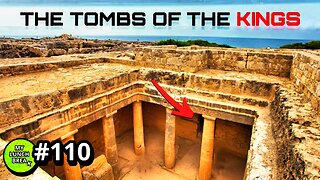Premium Only Content

How the East India Company Took Over An Entire Country
How the East India Company Took Over An Entire Country
-
578,572 views January 25, 2023
This Is History
-
Recommended reading: The Anarchy: The Relentless Rise of the East India Company - https://amzn.to/3wtuqAn The Honourable Company: A History of the English East India Company - https://amzn.to/3XQ3bMg Between Monopoly and Free Trade: The English East India Company, 1600-1757 - https://amzn.to/3j1pHTA The Indian Mutiny: 1857 - https://amzn.to/3kJzbmT
-
The city of London has been the centre of Britain’s economic and commercial activity for centuries, with many of the largest and wealthiest companies in the world choosing to locate their headquarters in the nation’s capital to this day. However, none of these modern businesses can compare to what was undoubtedly the most powerful multinational corporation the world has ever seen. Established over 400 years ago, the East India Company, from it’s headquarters on Leadenhall Street, would rise from humble beginnings as a trading company for voyages to India; to effectively becoming the de facto state government of the entire sub-continent.
-
During it’s heyday, the Company would surpass the strength and wealth of even the mightiest nation states, and with it’s own private armies, would push aside the long established native dynasties of India, seizing control of their territories for itself. All this would be achieved by maintaining an iron grip on the most valuable trade routes in the world, which generated staggering amounts of wealth for it’s employees and shareholders. But how did this private corporation come to rule over one of the largest and richest regions on earth in the first place?
-
This is the history of the East India Company. The East India Company (EIC) was an English, and later British, joint-stock company founded in 1600 and dissolved in 1874. It was formed to trade in the Indian Ocean region, initially with the East Indies (the Indian subcontinent and Southeast Asia), and later with East Asia. The company seized control of large parts of the Indian subcontinent and colonised parts of Southeast Asia and Hong Kong. At its peak, the company was the largest corporation in the world. The EIC had its own armed forces in the form of the company's three Presidency armies, totalling about 260,000 soldiers, twice the size of the British army at the time.
+
The operations of the company had a profound effect on the global balance of trade, almost single-handedly reversing the trend of eastward drain of Western bullion, seen since Roman times. Originally chartered as the "Governor and Company of Merchants of London Trading into the East-Indies", the company rose to account for half of the world's trade during the mid-1700s and early 1800s, particularly in basic commodities including cotton, silk, indigo dye, sugar, salt, spices, saltpetre, tea, and opium. The company also ruled the beginnings of the British Empire in India. The company eventually came to rule large areas of India, exercising military power and assuming administrative functions.
-
Company rule in India effectively began in 1757 after the Battle of Plassey and lasted until 1858. Following the Indian Rebellion of 1857, the Government of India Act 1858 led to the British Crown assuming direct control of India in the form of the new British Raj. The company subsequently experienced recurring problems with its finances, despite frequent government intervention. It was dissolved in 1874 under the terms of the East India Stock Dividend Redemption Act enacted one year earlier, as the Government of India Act had by then rendered it vestigial, powerless, and obsolete. The official government machinery of the British Raj had assumed its governmental functions and absorbed its armies.
-
FAIR USE FOR EDUCATIONAL PURPOSES
-
Mirrored From:
https://www.youtube.com/@this_is_history
-
 25:26
25:26
hickok45
4 hours agoSunday Shoot-a-Round # 265
6018 -
 30:55
30:55
Tundra Tactical
14 hours ago $13.70 earnedFaith, Family, Gun Rights : Tundra Tactical Interviews Erich Pratt Vice President Of GOA
66.4K9 -
 24:08
24:08
MYLUNCHBREAK CHANNEL PAGE
1 day agoUnder The Necropolis - Pt 4
212K54 -
 1:26:44
1:26:44
Tactical Advisor
22 hours agoTrump Starting Strong/Shot Show Recap | Vault Room Live Stream 015
110K9 -
 49:13
49:13
SGT Report
1 day agoGILDED CAGE: A.I. PRODUCED MRNA VACCINES & THE ROAD TO HELL -- Sam Anthony
54.6K378 -
 17:00
17:00
BIG NEM
13 hours agoI Spent 10 Years Making a Movie About a 40 Year Old VIRGIN
58 -
 17:01
17:01
RealitySurvival
10 hours agoRussia's Anti-Satellite Weapon Could Disable Your Commuter Car!
254 -
 4:13:39
4:13:39
Nobodies Gaming
16 hours ago $42.98 earnedNobodies : Rumble Gaming MARVEL RIVALS
244K12 -
 19:52
19:52
Adam Does Movies
14 hours ago $6.72 earnedEmilia Pérez Movie Review - It's Uniquely Awful
65.3K8 -
 20:07
20:07
BlackDiamondGunsandGear
20 hours agoSPRINGFIELD ECHELON COMPACT / NOT GOOD
58.7K7